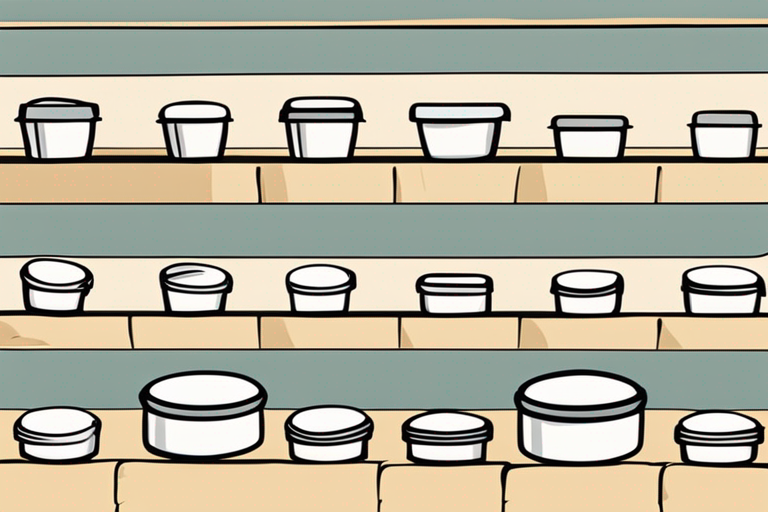
How Long Can You Keep Cream Cheese After the Expiration Date?
Get Your Free Food Safety Cheat Sheet
30 most common foods with instant answers. Print it and stick it on your fridge—completely free!
How Long Can You Keep Cream Cheese After the Expiration Date?
Cream cheese is a versatile and popular dairy product that can be used in both sweet and savory dishes. However, like all perishable foods, cream cheese has a limited shelf life, and it's important to know how long it can be safely consumed after the expiration date. In this blog post, we will explore the factors that affect the shelf life of cream cheese, how to properly store it, and when it's time to discard it.
Factors Affecting the Shelf Life of Cream Cheese
Several factors can influence the shelf life of cream cheese, including:
1. Packaging
The packaging of cream cheese plays a crucial role in determining its shelf life. Cream cheese that is sold in a sealed, airtight container will last longer than cream cheese that is sold in a non-sealed container.
2. Temperature
Temperature is another important factor that affects the shelf life of cream cheese. Cream cheese should be stored at a constant temperature of 40°F or below to prevent the growth of harmful bacteria.
3. Contamination
Contamination can also impact the shelf life of cream cheese. It's essential to use clean utensils when scooping out cream cheese to prevent the introduction of harmful bacteria.
4. Expiration Date
The expiration date on cream cheese packaging is a reliable indicator of its freshness and quality. While it's possible for cream cheese to be consumed safely after the expiration date, it's essential to exercise caution.
How Long Can You Keep Cream Cheese After the Expiration Date?
Cream cheese can typically be consumed safely for 1-2 weeks after the expiration date if it has been stored properly. However, it's crucial to use your judgment and rely on your senses to determine if the cream cheese is still safe to eat. Here are some guidelines to help you decide whether to keep or discard cream cheese after the expiration date:
Signs that Cream Cheese Has Gone Bad
- Mold growth: If you see mold on the surface of the cream cheese, it's a clear indication that it has spoiled.
- Unpleasant odor: If the cream cheese has a sour or off-putting smell, it's best to discard it.
- Change in texture: If the cream cheese has become slimy or grainy, it's no longer safe to eat.
Tips for Safely Consuming Cream Cheese After the Expiration Date
- Check the appearance and smell of the cream cheese before consuming it.
- If in doubt, it's best to err on the side of caution and discard the cream cheese.
- Avoid consuming cream cheese that has been left out at room temperature for an extended period.
Real-Life Scenarios
Let’s take a look at some relatable scenarios where knowledge about cream cheese shelf life could come in handy.
Scenario 1: Last-Minute Cheesecake
Imagine you’re gearing up for a family gathering and decide to whip up a cheesecake. You check your fridge and find a half-opened packet of cream cheese that expired last week. You wonder, “Can I use this?” You remember checking the color and smell, and it looks fine but is just a tad grainy. After a quick search, you decide to go ahead and use it, but you also add a bit of fresh cream to improve the texture. The cheesecake turns out great, and everyone loves it! This scenario illustrates the importance of assessing the cream cheese before deciding to discard it.
Scenario 2: A Spread for a Gathering
You’re hosting a brunch and planning to create a lovely bagel spread with cream cheese, lox, and capers. You come across a tub of cream cheese that expired three days ago. You’re not sure if it’s still good. Instead of risking it, you decide to play it safe and buy fresh cream cheese. Your guests are pleased, and you avoid any potential food safety issues. This highlights the importance of being cautious when serving others.
Scenario 3: A Forgotten Ingredient
Let’s say you bought cream cheese for a recipe, but life got busy, and it sat in the fridge for a couple of weeks after its expiration date. One evening, you’re in the mood for a snack and find that old container. It looks fine, and there’s no mold, but you remember the warnings about food safety. You decide to add it to your vegetable dip rather than eating it plain. This approach not only allows you to enjoy it safely but also prevents food waste.
Proper Storage of Cream Cheese
Proper storage is key to extending the shelf life of cream cheese. Here are some tips for storing cream cheese:
1. Refrigeration
Cream cheese should always be stored in the refrigerator at a constant temperature of 40°F or below. Store cream cheese in the coldest part of the refrigerator, away from the door to maintain a consistent temperature.
2. Sealed Container
Keep cream cheese in its original sealed container or transfer it to an airtight container to prevent contamination and exposure to odors from other foods.
3. Use Clean Utensils
Always use clean utensils when scooping out cream cheese to prevent contamination and spoilage.
4. Freeze for Longer Storage
If you have more cream cheese than you can use before it spoils, consider freezing it! Cream cheese can be frozen for up to two months without significant loss of quality. To freeze, simply place it in an airtight container or freezer bag, ensuring you remove as much air as possible. When you’re ready to use it, thaw it in the refrigerator overnight. It may have a slightly different texture, but it will still be safe to use in recipes.
Common Mistakes
Many people unknowingly make mistakes when it comes to the storage and consumption of cream cheese. Here are a few common pitfalls to avoid:
1. Leaving it Out Too Long
One of the biggest mistakes is leaving cream cheese out at room temperature for too long. It’s easy to forget to put it back in the fridge after baking or serving, but perishable dairy products should not be left out for more than two hours.
2. Ignoring Expired Dates
While the expiration date can provide guidance, it’s not the only factor to consider. Ignoring signs of spoilage based solely on the date is a mistake. Trust your senses—look, smell, and even taste (just a small bit) before deciding.
3. Not Covering It Properly
Failing to cover cream cheese properly can lead to freezer burn or absorption of other odors from the fridge. Always seal it tightly to maintain quality.
Expert Insights
Food safety experts recommend that when in doubt, it’s better to be safe than sorry. According to the USDA, soft cheeses like cream cheese can harbor harmful bacteria if not handled properly. Ensure you’re following safe storage practices, and remember that even if something looks and smells fine, if it’s been improperly stored or shows signs of spoilage, it’s best to discard it.
Scientific Context
Cream cheese, like other dairy products, is prone to spoilage due to the growth of bacteria, mold, and yeast. These microorganisms thrive in warm, moist environments and can cause foodborne illnesses. The pH level of cream cheese, which is slightly acidic, can help inhibit some bacteria, but it’s not immune to spoilage. Proper refrigeration slows down bacterial growth significantly, which is why it’s essential to keep it stored at the right temperature.
The nutritional content of cream cheese also plays a role in its appeal. It’s a source of calcium, protein, and vitamins A and B12, making it a favored ingredient in many diets. However, because it is high in fat, moderation is key. When using cream cheese past its expiration date, consider how much you're consuming, especially if you're using it in larger quantities.
Conclusion
In conclusion, cream cheese can be safely consumed for a short period after the expiration date if it has been stored properly and shows no signs of spoilage. However, it's crucial to use your judgment and rely on your senses to determine if the cream cheese is still safe to eat. By following proper storage guidelines and being mindful of signs of spoilage, you can enjoy cream cheese safely and deliciously. Whether it's for a decadent cheesecake, a savory dip, or a bagel spread, being informed about the safe use of cream cheese can enhance your culinary experiences while keeping food safety at the forefront.

Authoritative Food Safety References
These agencies and university labs inform every tip and health precaution we publish.
USDA FoodKeeper – Cold Storage Guidelines
Official refrigerator, freezer, and pantry timelines maintained by the U.S. Department of Agriculture.
Visit USDA FoodKeeperFDA Produce Safety Rule & Grower Guidance
Field-to-fridge handling practices that prevent contamination of fruits, vegetables, and leafy greens.
Visit FDA Produce SafetyCDC Foodborne Illness Prevention Hub
Surveillance-backed guidance on pathogens, symptoms, and steps to reduce foodborne illness risk.
Visit CDC Food SafetyUC Davis Postharvest Technology Center
University research detailing optimal storage atmospheres for produce after harvest.
Visit UC Davis PostharvestPenn State Extension – Home Food Preservation & Safety
Peer-reviewed extension bulletins on safe canning, chilling, and reheating practices.
Visit Penn State ExtensionCan you eat cream cheese after the expiration date?
How long does cream cheese last in the fridge after opening?
Can you freeze cream cheese to extend its shelf life?
What are the signs that cream cheese has gone bad?
Is it safe to eat cream cheese that has been left out at room temperature?
Get Your Free Food Safety Cheat Sheet
30 most common foods with instant answers. Print it and stick it on your fridge—completely free! Want more? Upgrade to the complete guide with 70+ foods.
Scan your food directly and get instant safety info using our AI-powered camera feature.